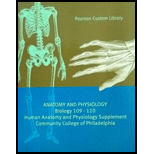
Concept explainers
Match each numbered item with the most closely related lettered item.
afferent division.................................
To review:
Match the term afferent division with the most closely related description given below:
Positive feedback
Connects initial segment to cell body
Sensory information
Monitor position/movement of joints
Myelin
One dendrite
Neuron cell bodies in PNS
Blood brain barrier (BBB)
Side branches of axons
Skeletal muscle cells
Introduction:
The nervous system is divided into two separate systems, namely the peripheral nervous system (PNS) and the central nervous system (CNS). The PNS consists of the all the nervous tissues. It is further divided into two parts, afferent and efferent divisions.
Explanation of Solution
The afferent division is a part of the PNS, which transfer sensory information obtained from the visceral and the somatic receptors to the CNS. There are many kinds of receptors, such as sense organs and specialized cells. The afferent division also transmits information from the sense organs, which includes the ear and eye.
Therefore, it can be concluded that the term afferent division can be correctly matched with option (c) sensory information.
Want to see more full solutions like this?
Chapter 13 Solutions
ANATOMY & PHYSIOLOGY COMM COLL PHILADELPHIA
- In a small summary write down:arrow_forwardNot part of a graded assignment, from a past midtermarrow_forwardNoggin mutation: The mouse, one of the phenotypic consequences of Noggin mutationis mispatterning of the spinal cord, in the posterior region of the mouse embryo, suchthat in the hindlimb region the more ventral fates are lost, and the dorsal Pax3 domain isexpanded. (this experiment is not in the lectures).a. Hypothesis for why: What would be your hypothesis for why the ventral fatesare lost and dorsal fates expanded? Include in your answer the words notochord,BMP, SHH and either (or both of) surface ectoderm or lateral plate mesodermarrow_forward
 Principles Of Radiographic Imaging: An Art And A ...Health & NutritionISBN:9781337711067Author:Richard R. Carlton, Arlene M. Adler, Vesna BalacPublisher:Cengage Learning
Principles Of Radiographic Imaging: An Art And A ...Health & NutritionISBN:9781337711067Author:Richard R. Carlton, Arlene M. Adler, Vesna BalacPublisher:Cengage Learning Human Physiology: From Cells to Systems (MindTap ...BiologyISBN:9781285866932Author:Lauralee SherwoodPublisher:Cengage Learning
Human Physiology: From Cells to Systems (MindTap ...BiologyISBN:9781285866932Author:Lauralee SherwoodPublisher:Cengage Learning Concepts of BiologyBiologyISBN:9781938168116Author:Samantha Fowler, Rebecca Roush, James WisePublisher:OpenStax College
Concepts of BiologyBiologyISBN:9781938168116Author:Samantha Fowler, Rebecca Roush, James WisePublisher:OpenStax College Human Biology (MindTap Course List)BiologyISBN:9781305112100Author:Cecie Starr, Beverly McMillanPublisher:Cengage Learning
Human Biology (MindTap Course List)BiologyISBN:9781305112100Author:Cecie Starr, Beverly McMillanPublisher:Cengage Learning





